Oxidative Medicine and Cellular Longevity
Special Issue on
Mechanisms of Cellular Rejuvenation
Aging is a complex process that produces a progressive decline of organs’ function affecting all living organisms. Although the aging rate is different among species, it always leads to an increase in disease susceptibility and health decline. Indeed, aging study has grown in the last years. Aging represents a well-known independent risk factor for most chronic no transmissible diseases, including cancer, cardiometabolic, respiratory and neurological diseases.
Cellular rejuvenation, which is defined as the reversion of an aged phenotype at cell level, is the greatest challenges in modern medicine for the treatment of aging-related diseases. The knowledge and understanding of the mechanisms of cellular rejuvenation will lead to the identification of novel research tools and development of innovative pharmacological therapies to improve the quality of life of aged population.
We encourage investigators of different disciplines to contribute original research articles as well as review articles that will stimulate the continuing efforts to understand the molecular mechanisms of aging and cellular rejuvenation. We are interested in articles that explore all aspects of the mechanisms of rejuvenation in cellular and animal models. Potential topics
include, but not limited to:
- Proteostasis
- Mitochondrial dynamics
- Cell bioenergetics
- Unfolded protein response (UPR) and mitochondrial UPR (mtUPR)
- Autophagy
- Cellular senescence
- Genomic instability
- Determinants of stem cells fate
- Rejuvenation and tissue regeneration
- Antioxidant cellular defense
- Rejuvenation factors and small molecules
- Rejuvenation signaling pathways
- Dietary supplement
| Manuscript Due | December 25, 2015 |
| First Round of Reviews | March 18, 2016 |
| Publication Date | May 13, 2016 |
Lead Guest Editor
Rodrigo Troncoso, Institute of Nutrition and Food Technology (INTA),
University of Chile, Santiago 7830490, Chile; rtroncoso@inta.uchile.cl
Guest Editors
Cristián Ibarra, Heart Failure Bioscience Department, Cardiovascular and
Metabolic Diseases (CVMD), Innovative Medicines and Early Development
(iMed) Biotech Unit, AstraZeneca R&D, 43150 Mölndal, Sweden;
cristian.ibarra@astrazeneca.com
Juan Pablo Muñoz, Institute for Research in Biomedicine (IRB Barcelona), CIBERDEM,
C/Baldiri Reixac 10, 08028, Barcelona, Spain;
juan.munoz@irbbarcelona.org
Valentina Parra, Advanced Center for Chronic Diseases, Faculty of Chemistry and Pharmacy,
University of Chile, Santiago 8380492, Chile;
vparra@ciq.uchile.cl


